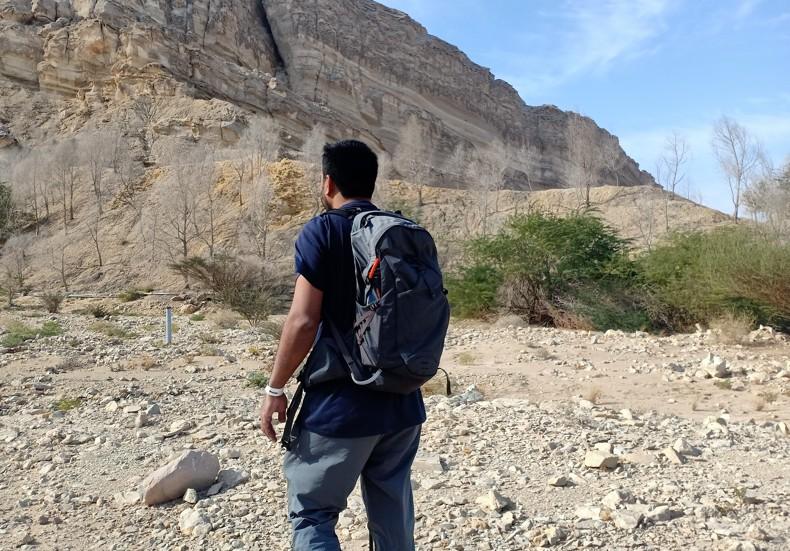When I first started hiking, I wasn’t looking for a life-changing hobby—I just needed to get outside, move a little, and clear my head. I didn’t have fancy gear, I didn’t know the “rules,” and honestly, I wasn’t sure I belonged out there. But after that first trail—muddy shoes, snack breaks, quiet views and all—I was hooked. And I’ve never looked back.
Do you know what is the best thing about hiking? It’s easily accessible. You don’t need technical skills or tons of equipment. Just a trail, a good pair of shoes, and the willingness to take that first step.
Related: Backpacking vs. Hiking: What’s the Real Difference?
In fact, hiking continues to be one of the fastest-growing outdoor activities in the U.S., especially for beginners—and for good reason. It’s low-barrier, endlessly flexible, and delivers both physical and mental health benefits from day one.
If you’re wondering how to start hiking, you’re in the right place. This guide is packed with everything I wish I knew when I first hit the trail: how to find beginner-friendly hikes, what gear you actually need (and what you don’t), safety tips, trail etiquette, and a few tools to help you grow your confidence with every mile.
Is Hiking Good for Beginners?
Hiking is one of the most beginner-friendly outdoor activities. You don’t need special training or expensive gear—just a good pair of shoes, a bottle of water, and a willingness to explore what’s outside your door. That’s the beauty of it.
Whether it’s a 3-mile local trail or a weekend adventure, hiking can build strength, reduce stress, and boost confidence. And the best part? It’s easy to learn. Just keep it simple, keep it local, and let the trail do the rest.
How to Choose Your First Trail
This is where most novice hikers make a mistake and then quit hiking. I’ve heard many new hikers on challenging terrain say that they won’t come back to hike again. So, how should you pick a trail? Your goal should be to keep it simple, low-stress, and confidence-boosting.
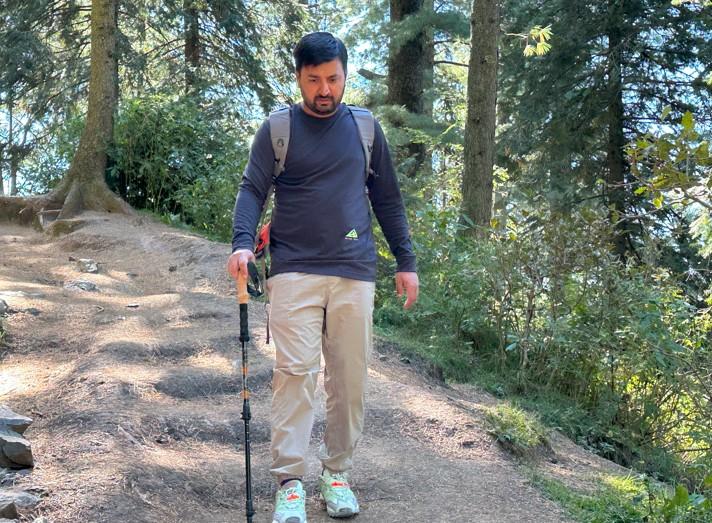
Look for easy hikes that are under 3 miles round trip, mostly flat, and don’t involve any tricky terrain. These short-day hikes on simple trails won’t overwhelm you. Trails such as forest loops, lakeside paths, and local nature trails are all great starting points.
You can use hiking apps like AllTrails, Gaia GPS, and Hiking Project to find trails. Filter by trail length, elevation gain, and difficulty. Read the user reviews.
A few things to check when browsing for trails:
- Elevation gain: More gain = more effort. For your first hike, aim for less than 300 feet.
- Surface type: Dirt, gravel, or paved trails are all fine—just make sure it’s well-marked and easy to follow.
- Weather forecast: Avoid your first hike in hot weather or during rain.
If you’re nervous, bring a friend—or choose a trail that’s well-trafficked. That will help boost your confidence when you’re just getting started.
What Should a Beginner Bring on a Hike?: Beginner Hiking Gear Essentials
For a day hike, pack essentials like water, snacks, a map, first-aid kit, and appropriate clothing. When I went on my first hike, I didn’t really know anything about outdoor gear. I just wore whatever I would normally wear, grabbed a backpack, and hit the trail. It didn’t take long to realize that a few simple pieces of proper gear can make a world of difference in comfort and performance.
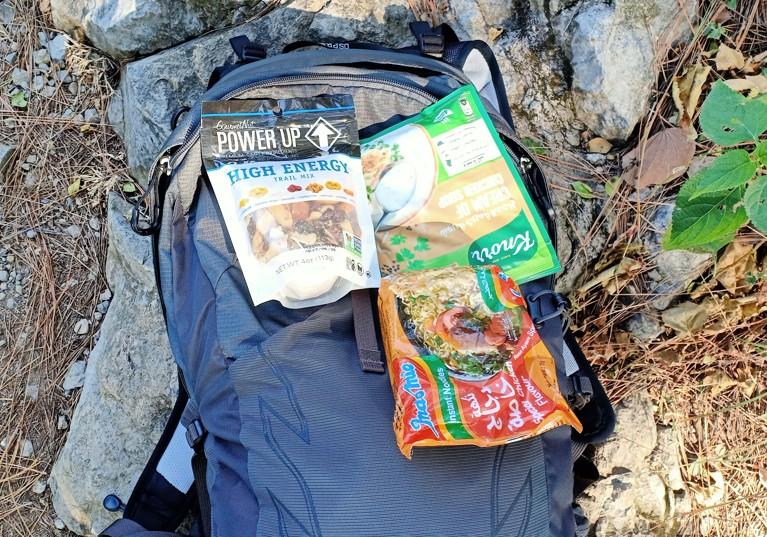
The best part? You don’t need a ton of expensive gadgets to get started. Hiking gear lists can seem super overwhelming, but if you stick to the basics—the essentials that keep you safe and comfortable—you’ll be all set.
Here’s what you actually need for a short day hike:
Daypack
You don’t need a massive backpack. A 15 to 25-liter pack is perfect for a day hike. Something like the Osprey Talon 22 works well—it’s lightweight, comfortable, and just the right size for your essentials.
Related: Best Osprey Daypack
Hiking Shoes for Beginners
You don’t need to splurge on pricey boots for an easy trail. Look for something that gives you good support and is comfy from the start, like the Columbia Crestwood hiking shoes. They won’t break the bank and still do the job.
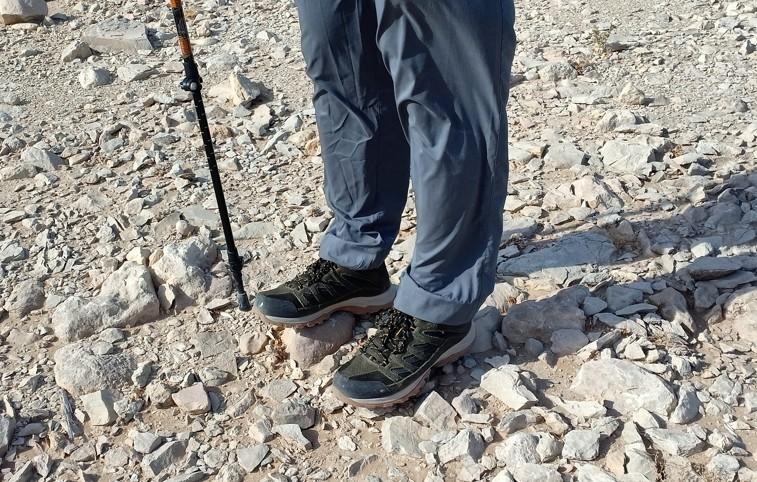
Blisters are a real threat on the trail and can completely derail your hike. And sore arches? They’ll make your first hiking day a miserable one. But here’s the good news: finding the best hiking shoes for beginners doesn’t mean spending a fortune—it’s all about choosing the right shoes for the kind of hiking you’re doing.
Make sure you break in your boots before hitting the trail, even if they feel comfy right off the bat. Wear the same socks you plan to hike in. Look for a snug fit around the heel, enough room in the toe box to wiggle your toes, and zero pressure points.
Socks
And don’t forget about socks. A good pair of moisture-wicking socks (think merino wool or synthetic) will help prevent blisters and keep you comfortable.
Darn Tough Hiker Micro Crew or Darn Tough Light Hiker Micro Crew socks are my personal favorites for this exact reason.
Water
Hydration is key, so bring enough water. Plan on about half a liter per hour of hiking, but it’s always better to have a little extra just in case.
A reusable water bottle, like a Nalgene or a collapsible bottle, is a smart move.
Map or App
On well-marked trails, you probably won’t need a map, but it’s always good to be prepared. I’ve never needed one on crowded, easy trails, but apps like AllTrails or Gaia GPS are super handy if you’re venturing somewhere new. Just make sure to download offline maps, especially if you’re worried about losing cell signal.
Snacks
A little fuel goes a long way. Pack easy snacks like trail mix, energy bars, or some fruit. They’re lightweight and keep you going without making you feel sluggish.
Sun Protection
You don’t want to mess around with sunburns. Make sure to bring sunscreen, sunglasses, and a hat—these will keep you protected and help you stay comfortable on sunny days.
How to Start Hiking for the First Time?
Now you have learned the basics about hiking essentials. It’s time to start hiking. Don’t get intimidated by your first hike.
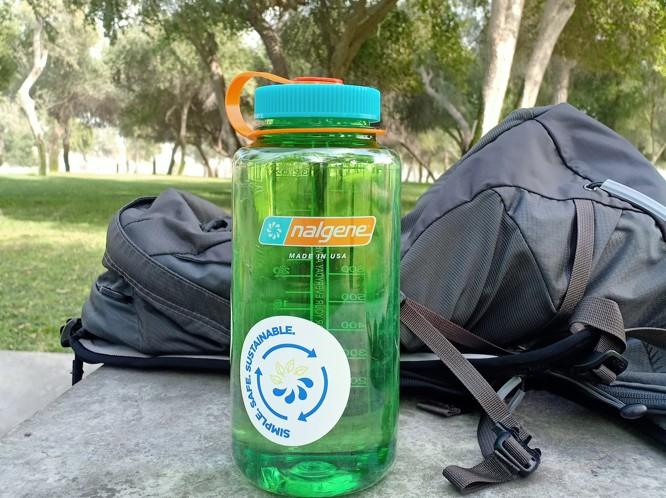
Here is the step-by-step guide on how to start hiking.
- Pick your trail
I always recommend starting with something short and well-marked. A 3 to 4-mile-long simple trail (with minimal elevation gain) is ideal to start your hiking. - Check the weather
Avoid hiking during storms, snow, or extreme heat. The backcountry can be risky in bad weather, so never take a chance if you are just a beginner. That’s why you’ll want to check the forecast before starting your hike. - Pack light
Use the basic hiking checklist that I shared above. You don’t need tons of gear for your few-hour hike. - Tell someone your plan
You might not feel the need for a simple hike, but it’s always best to inform someone before hitting the trail. I text a family member about my plan. - Start early
Start early during hot weather or on weekends to avoid the crowd. - Pace yourself
You don’t need to rush. Find a rhythm that you feel comfortable with. Don’t hesitate to take breaks when you need to. - Track your time
I keep an eye on how long it takes to get to the halfway point. That helps me estimate how much daylight I’ll need to get back—and keeps me from wandering too far out. - Build up slowly
Resist the urge to go big right away. I started with short, flat hikes and gradually worked up to longer ones with more elevation.
There’s no perfect formula when it comes to hiking tips for first-timers, but these steps will set you up for a smooth experience. The more you get out there, the more your confidence—and your love for hiking—will grow.
Common Beginner Mistakes to Avoid
A few easy-to-miss mistakes can turn a fun hike into a frustrating one. Here’s what I learned to avoid early on:
- Wearing cotton — Cotton stays wet and cold. Go for synthetics or wool.
- Not drinking enough water — hydrate often, even if you’re not thirsty.
- Overpacking or forgetting essentials — find the balance.
- Relying only on your phone — bring offline maps or a backup.
- Skipping the safety check-in — always tell someone where you’re going.
- Ignoring the weather — check the forecast and pack layers.
Trail Etiquette and Community
One of the things I love most about hiking is the sense of community you feel out on the trail. Even if you’re hiking solo, there’s this quiet connection between people who are out there for the same reason—to unplug, explore, and enjoy nature. That said, a little trail etiquette goes a long way in keeping that experience positive for everyone.
- Say hello to fellow hikers
A quick smile or “hey there” is standard trail speak. It’s simple, friendly, and helps build a welcoming vibe out on the trail. - Know who yields
One of the golden rules: hikers going uphill have the right of way. They’re working harder to keep momentum, so step aside and give them space if you’re heading down. It’s a small gesture that makes a big difference. - Keep pets under control
Not everyone loves dogs, and some hikers may be nervous around them. Leashing up is part of keeping the trail safe and respectful for everyone. - Skip the speaker
If you want tunes, use headphones and keep one ear open so you stay aware of your surroundings. - Respect nature
Stay on the trail, even if there’s a muddy patch or a shortcut that looks tempting. Cutting switchbacks or trampling plants may seem harmless, but it adds up over time and causes real damage. I always remind myself: take only pictures, leave only footprints.
Conclusion
If there’s one thing I want you to take from all this, it’s that hiking doesn’t have to be complicated. You don’t need to be a fitness expert, own a ton of fancy gear, or conquer a mountain right away. The key is to start small, stay safe, and enjoy the journey. That’s how every experienced hiker got started—one step at a time.
The trail will teach you as you go. Each hike will reveal a little more about what you need, what you enjoy, and how your confidence grows with every mile. Whether you’re tackling a short loop or going for your first full-day hike, you’ve already taken the most important step: deciding to begin.
And when you do get out there? Come back and share your experience in the comments—I’d love to hear all about your first hike.
Related: Best Hiking Books
